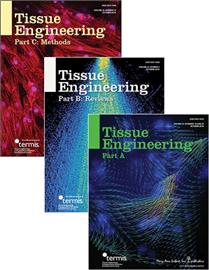
Credit: ©Mary Ann Liebert, Inc., publishers
New Rochelle, NY, November 4, 2016–New research explains how metastatic breast cancer cells might use bone marrow-derived mesenchymal stem cells (MSCs) to help them spread to bone tissue. A study using a 3D scaffold model has shown that breast tumor-derived factors can promote the maturation of MSCs into bone cells, and that mechanical compression of the scaffold further stimulates bone development, according to an article published in Tissue Engineering, Part A, a peer-reviewed journal from Mary Ann Liebert, Inc., publishers. The article is available free for download on the Tissue Engineering website until December 2, 2016.
Maureen Lynch, Claudia Fischbach, and coauthors from Cornell University (Ithaca, NY) and University of Massachusetts Amherst used a mineral-containing 3D scaffold as an in vitro model to study whether factors such as breast tumor-derived compounds and mechanical stimulation within the bone microenvironment affect the interactions between metastatic cancer cells and bone. Understanding and intervening in these interactions could have clinical implications for the nearly 75% of patients with advanced breast cancer in whom incurable skeletal metastatic disease develops.
The article entitled "Three-Dimensional Mechanical Loading Modulates the Osteogenic Response of Mesenchymal Stem Cells to Tumor-Derived Soluble Signals" describes the composition of the scaffold, the study design, and how this model can be used to evaluate the role of certain physical cues on bone metastatic breast cancer.
"The article reports a very exciting study leveraging a tissue-engineered tumor model for controlled interrogation of tumor-bone interactions with enormous implications for the development of new therapeutics" says Co-Editor-in-Chief Antonios G. Mikos, PhD, Louis Calder Professor at Rice University, Houston, TX.
###
Research reported in this publication was supported by the National Cancer Institute under NIH Award NumberR01CA17303. The content is solely the responsibility of the authors and does not necessarily represent the official views of the National Institutes of Health.
About the Journal
Tissue Engineering is an authoritative peer-reviewed journal published monthly online and in print in three parts: Part A, the flagship journal published 24 times per year; Part B: Reviews, published bimonthly, and Part C: Methods, published 12 times per year. Led by Co-Editors-In-Chief Antonios G. Mikos, PhD, Louis Calder Professor at Rice University, Houston, TX, and Peter C. Johnson, MD, Principal, MedSurgPI, LLC and President and CEO, Scintellix, LLC, Raleigh, NC, the Journal brings together scientific and medical experts in the fields of biomedical engineering, material science, molecular and cellular biology, and genetic engineering. Tissue Engineering is the official journal of the Tissue Engineering & Regenerative Medicine International Society (TERMIS). Complete tables of content and a sample issue may be viewed online at the Tissue Engineering website.
About the Publisher
Mary Ann Liebert, Inc., publishers is a privately held, fully integrated media company known for establishing authoritative peer-reviewed journals in many promising areas of science and biomedical research, including Stem Cells and Development, Human Gene Therapy, and Advances in Wound Care. Its biotechnology trade magazine, GEN (Genetic Engineering & Biotechnology News), was the first in its field and is today the industry's most widely read publication worldwide. A complete list of the firm's 80 journals, books, and newsmagazines is available on the Mary Ann Liebert, Inc., publishers website.
Media Contact
Jennifer Gatti
[email protected]
914-740-2100
@LiebertPub
http://www.liebertpub.com





